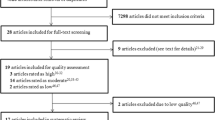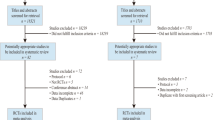Abstract
Older adults spend more than 8 h/day in sedentary behaviours. Detrimental effects of sedentary behaviour (SB) on health are established, yet little is known about SB and bone health (bone mineral density; BMD) in older adults. The purpose of this review is to examine associations of SB with BMD in older adults. Five electronic databases were searched: Web of Science (Core Collection); PubMed; EMBASE; Sports Medicine and Education and PsycInfo. Inclusion criteria were healthy older adults mean age ≥ 65 years; measured SB and measured BMD using dual-energy X-ray absorptiometry. Quality was assessed using National Institute of Health Quality Assessment Tool for Observational Cohort and Cross-Sectional Studies. After excluding duplicates 17813 papers were assessed; 17757 were excluded on title/abstract, 49 at full text, resulting in two prospective and five cross-sectional observational studies reviewed. Four were rated ‘good’ and three were rated ‘fair’ using the quality assessment criteria. Findings varied across the studies and differed by gender. In women, four studies reported significant positive associations of SB with BMD at different sites, and two found significant negative associations. Five studies which examined both men and women, men reported negative or no associations of SB with femoral neck, pelvic, whole body, spine or leg BMD. Whilst these findings suggest differences between men and women in the associations of SB with BMD, they may be due to the varying anatomical sections examined for BMD, the different methods used to measure SB, the varied quality of the studies included and the limited number of published findings.

Similar content being viewed by others
Abbreviations
- BMD:
-
Bone mineral density
- DXA:
-
Dual-X-ray absorptiometry
- FN:
-
Femoral neck
- LPA:
-
Light physical activity
- LS:
-
Lumbar spine
- MVPA:
-
Moderate-to-vigorous physical activity
- PA:
-
Physical activity
- SB:
-
Sedentary behaviour
- ST:
-
Sedentary time
- TB:
-
Total body
- TF:
-
Total femur
- TH:
-
Total hip
- TS:
-
Total spine
References
Tremblay MS et al (2017) Sedentary Behavior Research Network (SBRN) – Terminology Consensus Project process and outcome. Int J Behav Nutr Phys Act 14:75–91
Tremblay MS, Colley RC, Saunders TJ, Healy GN, Owen N (2010) Physiological and health implications of a sedentary lifestyle. Appl Physiol Nutr Metab 35:725–740
Biswas A, Oh PI, Faulkner GE, Bajaj RR, Silver MA, Mitchell MS, Alter DA (2015) Sedentary time and its association with risk for disease incidence, mortality, and hospitalization in adults: a systematic review and meta-analysis. Ann Intern Med 162:123–132
Chrysant SG, Chrysant GS (2015) The cardiovascular consequences of excess sitting time. J Clin Hypertens 17:528–531
Hu FB, Li TY, Colditz GA, Willett WC, Manson JE (2003) Television watching and other sedentary behaviours in relation to risk of obesity and type 2 diabetes mellitus in women. J Am Med Assoc 289:1785–1791
Falck RS, Davis JC, Liu-Ambrose T (2017) What is the association between sedentary behaviour and cognitive function? A systematic review. Br J Sports Med 51:800–811
Chastin SFM, Schwarz U, Skelton DA (2013) Development of a consensus taxonomy of sedentary behaviors (SIT): report of Delphi Round 1. PLoS One 8:e82313
Copeland J et al (2017) Sedentary time in older adults: a critical review of measurement, associations with health, and interventions. Br J Sports Med 51:1539–1539
Harvey JA, Chastin SFM, Skelton DA (2013) Prevalence of sedentary behavior in older adults: a systematic review. Int J Environ Res Public Health 10:6645–6661
Harvey JA, Chastin SF, Skelton DA (2015) How sedentary are older people? A systematic review of the amount of sedentary behavior. J Aging Phys Act 23:471–487
Bonjour JP, Chevalley T, Ferrari S, Rizzoli R (2009) The importance and relevance of peak bone mass in the prevalence of osteoporosis. Salud Publica Mex 51:S5–S17
Demontiero O, Vidal C, Duque G (2012) Aging and bone loss: new insights for the clinician. Ther Adv Musculoskel 4:61–76
Abrahamsen B, Brask-Lindemann D, Rubin KH, Schwarz P (2014) A review of lifestyle, smoking and other modifiable risk factors for osteoporotic fractures. Bone Key Rep 3:574–580
National Osteoporosis Society (2018) Strong, steady and straight: an expert consensus statement on physical activity and exercise for osteoporosis. https://www.bgs.org.uk/sites/default/files/content/attachment/2019-02-20/FINAL%20Consensus%20Statement_Strong%20Steady%20and%20Straight_DEC18.pdf Accessed 21 May 2020.
van Staa TP, Dennison EM, Leufkens HGM, Cooper C (2001) Epidemiology of fractures in England and Wales. Bone 29:517–522
Svedbom A, Hernlund E, Ivergard M et al (2013) Osteoporosis in the European Union: a compendium of country-specific reports. Arch Osteoporos 8:137–355
Leal J, Gray AM, Prieto-Alhambra D et al (2016) Impact of hip fracture on hospital care costs: a population-based study. Osteoporos Int 27:549–558
Kohrt WM, Barry DW, Schwartz RS (2009) Muscle forces or gravity: what predominates mechanical loading on bone? Med Sci Sports Exerc 41:2050–2055
LeBlanc AD, Spector ER, Evans HJ, Sibonga JD (2007) Skeletal responses to space flight and bed rest: a review. J Musculoskelet Neuronal Interact 7:33–47
Keodijk JB, van Rijswijk J, Oranje WA et al (2017) Sedentary behaviour and bone health in children, adolescents and young adults: a systematic review. Osteoporos Int 28:2507–2519
Vaitkeviciute D, Latt E, Maestu J, Jurimae T, Saar M, Purge P, Maasalu K, Jurimae J (2014) Physical activity and bone mineral accrual in boys with different body mass parameters during puberty: a longitudinal study. PLoS One 9:e107759
Naganathan V, Sambrook P (2003) Gender differences in volumetric bone density: a study of opposite-sex twins. Osteoporos Int 14:564–569
Chastin S, Mandrichenko O, Helbostadt J, Skelton DA (2014) Associations between objectively-measured sedentary behaviour and physical activity with bone mineral density in adults and older adults, the NHANES study. Bone 64:254–262
Liberati A, Altman DG, Tetzlaff J, Mulrow C, Gotzsche PC, Ioannidis JPA, Clarke M, Devereaux PJ, Kleijnen J, Moher D (2009) The PRISMA statement for reporting systematic reviews and meta-analyses of studies that evaluate health care interventions: explanation and elaboration. BMJ 339:b2700
Moher D, Liberati A, Tetzlaff, J Altman, DG, Grp P (2009) Preferred Reporting Items for Systematic Reviews and Meta-Analyses: The PRISMA Statement. BMJ 339:b2535.
National Institutes of Health National Heart, Lung and Blood Institute (n.d.) Study quality assessment tools. https://www.nhlbi.nih.gov/health-topics/study-quality-assessment-tools. Accessed 30 September 2019.
Braun SI, Kim Y, Jetton AE, Kang M, Morgan DW (2015) Prediction of bone mineral density and content from measures of physical activity and sedentary behaviour in younger and older females. Prev Med Rep 2:300–305
McMillan LB, Aitken D, Ebeling P, Jones G, Scott D (2018) The relationship between objectively assessed physical activity and bone health in older adults differs by sex and mediated by lean mass. Osteoporos Int 29:1379–1388
Nguyen TV, Sambrook PN, Eisman JA (1998) Bone loss, physical activity, and weight change in elderly women: The Dubbo osteoporosis epidemiology study. J Bone Miner Res 13:1458–1467
Onambele-Pearson G, Wullems J, Doody C, Ryan D, Morse C, Degens H (2019) Influence of habitual physical behavior – sleeping, sedentarism, physical activity – on bone health in community-dwelling older people. Front Physiol 10:1–15
Rodriguez-Gomez I, Manas A, Losa-Reyna J et al (2018) Associations between sedentary time, physical activity and bone health among older people using compositional data analysis. PLoS One 13:1–17
Rodriguez-Gomez I, Manas A, Losa-Reyna J et al (2019) The impact of movement behaviours on bone health in elderly with adequate nutritional status: compositional data analysis depending on frailty status. Nutr 11:582–594
Fried LP, Tangen CM, Walston J, Newman AB, Hirsch C, Gottdiener J, Seeman T, Tracy R, Kop WJ, Burke G, McBurnie MA (2001) Frailty in older adults: evidence for a phenotype. J Gerontol Ser A Med Sci 56:M146–M156
Braun SI, Kim Y, Jetton AE, Kang M, Morgan DW (2017) Sedentary behaviour, physical activity, and bone health in postmenopausal women. J Aging Phys Act 25:173–181
Harvey JA, Chastin SFM, Skelton DA (2018) Breaking sedentary behaviour has the potential to increase / maintain function in frail older adults. J Frailty Sarcop Falls 4:26–34
Aunger JA, Greaves CJ, Davis ET, Asamane EA, Whittaker AC, Greig CA (2020) A novel behavioural INTErvention to REduce Sitting Time in older adults undergoing orthopaedic surgery (INTEREST): results of a randomised-controlled feasibility study. Aging Clin Exp Res 32:2565–2585. https://doi.org/10.1007/s40520-020-01475-6
Shephard RJ (2003) Limits to the measurement of habitual physical activity by questionnaires. Br J Sports Med 37:197–206
Chastin SFM, Dontje ML, Skelton DA, Čukić I, Shaw RJ, Gill JMR, Greig CA, Gale CR, Deary IJ, Der G, Dall PM (2018) Systematic comparative validation of self-report measures of sedentary time against an objective measure of postural sitting (activPAL). Int J Behav Nutr Phys Act 15:21–32
Strain T, Milton K, Dall P, Standage M, Mutrie N (2019) How are we measuring physical activity and sedentary behaviour in the four home nations of the UK? A narrative review of current surveillance measures and future directions. Br J Sports Med 0:1-9.
Kim SJ, Yang WG, Cho E, Park EC (2012) Relationship between weight, body mass index and bone mineral density of lumbar spine in women. J Bone Metab 19:95–102
Felson DT, Zhang Y, Hannan MT, Anderson JJ (1993) Effects of weight and body mass index on bone mineral density in men and women: the Framingham study. J Bone Miner Res 8:567–573
Reid IR (2002) Relationships among body mass, its components, and bone. Bone 31:547–555
Nielson CM, Srikanth P, Orwoll ES (2012) Obesity and fracture in men and women: an epidemiologic perspective. J Bone Miner Res 27:1–10
Iwaniec UT, Turner RT (2016) Influence of body weight on bone mass, architecture, and turnover. J Endocrinol 230:R115–R130
Funding
This study was supported by a grant from the Royal Osteoporosis Society.
Author information
Authors and Affiliations
Corresponding author
Ethics declarations
Conflict of interest
Dawn A. Skelton is a Director of a not for profit training company, Later Life Training, which provides training to health and leisure professionals to deliver strength and balance training.
Neville Owen is supported by a National Health and Medical Research Council of Australia (NHMRC) Centre of Research Excellence Grant (#1057608), NHMRC Senior Principal Research Fellowship (#1118225), and the Victorian Government’s Operational Infrastructure Support Program. David W. Dunstan is supported by a NHMRC Senior Research Fellowship #1078360 and the Victorian Government’s Operational Infrastructure Support Program.
Lauren McMichan, Michael Dick, Sebastien F.M. Chastin, Neville Owen, David W. Dunstan, William D. Fraser, Jonathan C.Y. Tang, Carolyn A. Greig, Sandra Agyapong-Badu, and Alexandra Mavroeidi declare no conflict of interests.
Additional information
Publisher’s note
Springer Nature remains neutral with regard to jurisdictional claims in published maps and institutional affiliations.
Supplementary information
ESM 1
(DOCX 18.9 kb)
Rights and permissions
About this article
Cite this article
McMichan, L., Dick, M., Skelton, D. et al. Sedentary behaviour and bone health in older adults: a systematic review. Osteoporos Int 32, 1487–1497 (2021). https://doi.org/10.1007/s00198-021-05918-2
Received:
Accepted:
Published:
Issue Date:
DOI: https://doi.org/10.1007/s00198-021-05918-2




